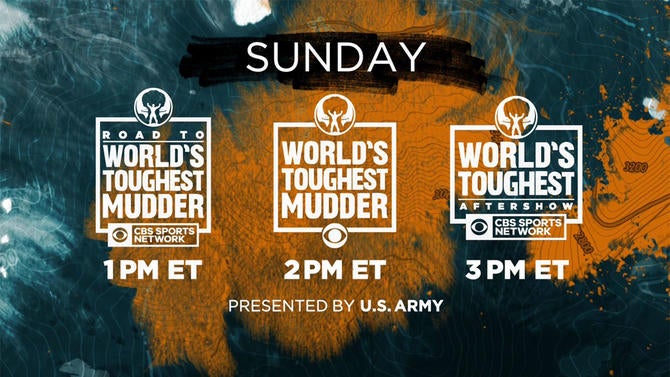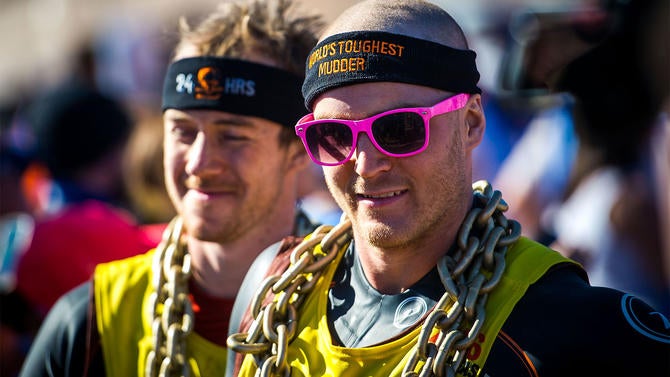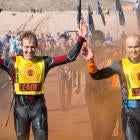Imagine doing the craziest, most grueling, challenging five-mile race you can think of, complete with obstacles you've never seen designed to torture you at every turn.
Now imagine running that course on a loop for 24 straight hours.
That's exactly what the competitors in this year's "World's Toughest Mudder" did at Lake Las Vegas on Nov. 12, braving over 20 obstacles and 800 feet of elevation to complete one of the toughest races imaginable.
You can find out exactly how hard the race is by watching the hour-long premiere on Dec. 25 at 2 p.m. ET on CBS. Immediately following, CBS Sports Network will air the "World's Toughest Aftershow" at 3 p.m. Host Brent Stover, three-time "World's Toughest Mudder" champion Amelia Boone and special guests will dive into race analysis. Top athletes will relive the 24-hour experience of overcoming elements and harrowing obstacles such as The Cliff, Augustus Goop and Kong.
We spoke with the most insane competitor of them all, Ryan Atkins, who became the first person to ever go over 100 miles at "World's Toughest Mudder" in 2013. The 28-year-old Canadian competed with partner Jon Albon this year in the team competition with the goal of reaching 100 miles and taking home the $100,000 grand prize.

Q: What got you into "Tough Mudder" in the first place?
Ryan Atkins: I had kind of been looking for something that was really challenging, really hard. I just wanted to challenge myself and see how far I could go, and this was a great conduit to do that.
Q: What's the preparation that goes into a 24-hour race, both mentally and physically?
RA: With these races, at some point it's going to be really hard -- your body's going to shut down or it's just going to get really sucky at some point. So all the training is basically just trying to prolong that point so that it doesn't happen six hours in -- maybe it happens 18 hours in instead. It just makes things a lot more manageable so you're able to go a lot quicker.
Q: If you're racing for 24 hours, obviously you're going to have to go to the bathroom. Do you just let it go?
RA: Well, you're in a wetsuit and you're in and out of water, so peeing isn't really a problem because you're just constantly wet anyway. Number two is definitely a bit of an issue. I had to do it once this year, and it wasn't so bad. Me and my partner actually timed it so we went at the same time, so that was pretty remarkable I think.
Q: There must be a lot of injuries involved in these 24-hour races. Do you ever a complete a race without an injury?
RA: I mean, usually something's going to be pretty sore. I don't think I came away with any injuries to speak of this year, but I was definitely really sore for the next few days. I remember the first year that I did it, though, I had my shoulder completely shut down, so I couldn't move my right arm for about a week after the race -- I had to have it in a sling. It was pretty funny, actually.
Q: What's the craziest thing that's happened to you during a race?
RA: The thing with these races is that they're kind of designed so that s--- happens to you. It's not a matter of if something is going to happen, it's a matter of when. Something weird or messed up is going to happen to you over and over.
I remember this year I got kicked in the face like three times pretty hard -- that was like, "Oh, OK, yeah I'm awake, like that really hurt.' One of the times it was my partner, accidentally. We were going over an obstacle right beside each other and he completely maimed me right in the head, and I was like, "Oh dude, what are you doing?" But he was just getting me back, because I stepped on his finger the lap before that.
Q: What are some of your favorite obstacles?
RA: There's a big cliff jump at "World's Toughest Mudder" -- it's about 35 feet into water -- and they only open it at night. So that's a really cool obstacle because you kind of have to overcome a fear of heights and you have to hit the water just right so you don't smash yourself off the water, because you're coming at it pretty quick.
Q: What are your least favorite obstacles?
RA: There was a balance beam which is usually pretty fun, but in a 24-hour race you're just constantly afraid that you're going to -- because you start getting pretty delirious and losing your balance and stuff -- I was really concerned that I was going to fall and crush my nuts on that one. A legitimate concern, I feel.
Q: Do you get scared during these events?
RA: You have to kind of have some element of trust toward the race organizers, and I know the guys at "Tough Mudder" pretty well and they're really good guys. I trust that they're going to test everything really well before I have to go over it, and it's going to be safe. For them I know it's a really hard line to create obstacles that are still safe for all the participants, but also introduce that element of fear at the same time. I think they do a really good job of it.
Before the event there's definitely a lot of anticipation and trepidation because you don't really know what to expect -- you don't know what the obstacles will be like. That can be a bit scary, but once you get on the course and everything starts flowing and you're having a good time out there, the fear goes away, I guess.

Q: What do your parents think about you doing these races?
RA: I think they think it's cool, but I don't know what they'd think if they actually came to an event -- just how extreme and hard it can get out there.
Q: How long do you think you can keep this up?
RA: I think I'm doing it in a way where I can foreseeably be back for another 5-10 years. There are people who are out there doing it in their 50s and 60s -- but I think as far as the competitive athletes at the front of the race, usually about 40 is the upper limit of where people are still stretching it out there.
















